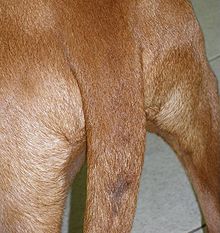Violet gland

The violet gland or supracaudal gland is a
It is used for intra-species signalling,
By species
In dogs, the violet or supracaudal gland is found approximately above the 9th caudal vertebra, but depending on breed it may be vestigial or entirely absent. The violet gland secretes protein and hydrophobic lipids, has wide excretory ducts, is connected with coarse hairs, devoid of cysts, and has no sexual dimorphism. In the dog and cat fancy it is often referred to as "stud tail", despite the fact that it occurs in both sexes, not just breeding males. However, for reasons still unknown the hair at a dog's violet gland tends to fall out when androgen levels are high over a prolonged time. In short-haired breeds the usually inconspicuous gland may thus appear as a noticeably sparsely haired patch, and it is this condition of the gland area that is most frequent in stud dogs.
In foxes, the violet gland is found on the upper surface of the tail, at roughly one-third of the tail's length from the body, and measures about 25 by 7.5
.References
- ISBN 978-0-226-51698-1.
- .
- ^ Deveaux, Renée Esther, Nachweis verschiedener Drüsentypen und mehrerer Hydroxysteroid-Dehydrogenasen im dorsalen Schwanzorgan (Supracaudal gland in dog & fox). D.V.M. thesis, Veterinary Medical Faculty, Bern University 1984
- PMID 9410272.
External links
